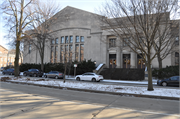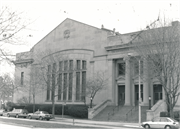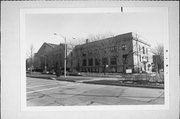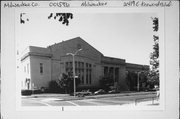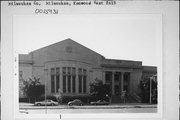Property Record
2419 E KENWOOD BLVD
Architecture and History Inventory
| Historic Name: | Temple Emanu-el B'ne Jeshurun |
|---|---|
| Other Name: | Temple Emanu-el B'ne Jeshurun |
| Contributing: | Yes |
| Reference Number: | 15931 |
| Location (Address): | 2419 E KENWOOD BLVD |
|---|---|
| County: | Milwaukee |
| City: | Milwaukee |
| Township/Village: | |
| Unincorporated Community: | |
| Town: | |
| Range: | |
| Direction: | |
| Section: | |
| Quarter Section: | |
| Quarter/Quarter Section: |
| Year Built: | 1922 |
|---|---|
| Additions: | |
| Survey Date: | 19932023 |
| Historic Use: | house of worship |
| Architectural Style: | Neoclassical/Beaux Arts |
| Structural System: | |
| Wall Material: | Limestone |
| Architect: | Robert and Henry Messmer |
| Other Buildings On Site: | |
| Demolished?: | No |
| Demolished Date: |
| National/State Register Listing Name: | Not listed |
|---|---|
| National Register Listing Date: | |
| State Register Listing Date: |
| Additional Information: | "A 'site file' exists for this property. It contains additional information such as correspondence, newspaper clippings, or historical information. It is a public record and may be viewed in person at the Wisconsin Historical Society, Division of Historic Preservation-Public History. 2023- resurveyed as part of Milwaukee Houses of Worship thematic survey. Original cost was $500,000. Neo-classical synagogue with a cut Indiana limestone exterior. ""This synagogue represents the merger of Milwaukee's two oldest Jewish Reformed congregations, Emanu-El and B'ne Jeshurun. See Louis Swichkow, A History of the Jews in Milwaukee, for a history of the congregations. In 1922, having outgrown a downtown synagogue, Emanu-El (established 1869) constructed this building on suburban Kenwood Boulevard. Five years later, B'ne Jeshurun (established 1858) merged with Emanu-El to form Milwaukee’s oldest and largest Jewish temple. Members worship in a severe but dignified building, designed in an unadorned classical style. Only the cornice and columns at the main entry and the pediments over the Stowell Avenue side entries punctuate the flat limestone walls. An incised Star of David is the gable’s only feature. The façade’s focus point is a generous segmentally arched stained-glass window that lights the domed auditorium. The design solves the problem that faced many early twentieth century non-Orthodox Jewish congregations when choosing an architectural style. Jews did not have an architectural tradition in Europe to draw upon. Christian ecclesiastical architecture seemed inappropriate, and the only so-called ""Jewish style,"" the one based on Islamic and Byzantine architectural models, was often identified with America’s Orthodox congregations. So Emanu-El, a Reform congregation, turned to the secular Neoclassical style for their new building, much as Christian Scientists did for their new churches."" (Paul Jakubovich, Buildings of Wisconsin entry.)" |
|---|---|
| Bibliographic References: | BUILT IN MILWAUKEE, LANDSCAPE RESEARCH, P. 137. Cornerstone of building. Young, Mary Ellen and Wayne Attoe, Places of Worship Milwaukee, (Milw., 1977), p. 35. Building Permit. Buildings of Wisconsin manuscript. |
| Wisconsin Architecture and History Inventory, State Historic Preservation Office, Wisconsin Historical Society, Madison, Wisconsin |

